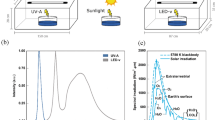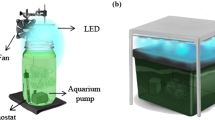Abstract
Removal rates of a toxic pollutant-hydrogen sulfide were investigated using several light sources in photosynthetic desulfurization. An incandescent bulb has a broad spectrum starting from about 400 nm but emits most of its light energy beyond 800 nm as heat. LED710 among those sources saved energy considerably comparing with the incandescent light, but the scattering and absorption was a problem in light transmission within the deep region of a bioreactor due to its own weak light intensity. Fluorescent light was inefficient in desulfurization in comparison with light sources illuminating with wide wavelength range, because of the weak transmittance at the peak wavelength of 460 nm. A combination of LED710 and fluorescent lamp was estimated as an optimal light source in this study.
Similar content being viewed by others
Author information
Authors and Affiliations
Additional information
Received: 29 January 1997
Rights and permissions
About this article
Cite this article
Kim, B., Chang, K. & Chang, H. Effect of light source on the microbiological desulfurization in a photobioreactor. Bioprocess Engineering 17, 343–348 (1997). https://doi.org/10.1007/s004490050395
Issue Date:
DOI: https://doi.org/10.1007/s004490050395




